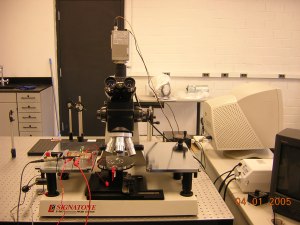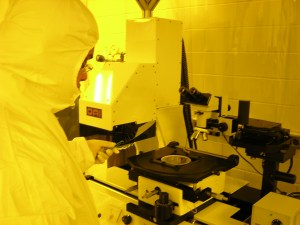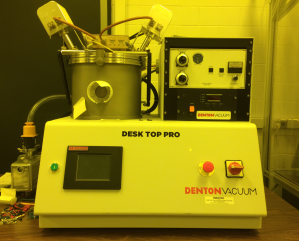Facility
The Microelectromechanical Systems (MEMS) Lab, located in Room 414 and Room 417 of the Auburn Science and Engineering Center, is a facility for design, analysis, modeling, fabrication, and characterization of MEMS devices and transducers. The lab was built in spring 2004 and contains about 1000 square feet of cumulative lab space. Prof. Jiang Zhe is the director of the MEMS Lab.
The lab is equipped with two class 1000 chemical exhaust hoods and one 200 square feet class 100 clean room space. The MEMS lab is capable of photolithography, thin film deposition and wet etching. Available in the lab for MEMS fabrication are an OAI 206 UV mask aligner, Laurell WS-400B-6NPP/LITE spin-coater, a Denton Deskpro DC/RF sputtering system, a Harrick PDC-32G plasma cleaner, a MTI CNC-400 diamond dicing saw, an Isotemp 280A vacuum oven, a Branson 3510 ultrasonic agitator, Barnstead SP131925Q digital hot plates, a Delta press drill for plastic and glass drilling, and a Delta band saw for plastic and soft metal cutting. The class 100 clean room space is equipped to house the mask aligner, spin coater, sputtering system, plasma asher, a Signatone S-1160 probe station, a Dektak 150 surface profilometer, and a Mitutoyo FS70 high precision microscope. Two wet process benches are housed in the class 1000 exhaustive hoods.
Available in the lab for MEMS testing and characterization are a Signatone S-1160 probe station, a Dektak 150 surface profilometer, a Mitutoyo FS70 high precision microscope, a Olumpus Ix-71 inverted microscope, a Agilent DSO6054A 500 MHz oscilloscope, a HP precision 4980A LCR meter, a Q-Imaging 1394 high speed CCD camera, HAMEG 800HZ oscilloscope, Tektronix 200HZ digital oscilloscopes, Agilent 33120A arbitrary waveform generators, Agilent E3630A power supplies, HP 1650A logic analyzer, HP 5335A frequency counter, Wavetek and HP signal generators, a Panasonic WV-CP454 CCD camera, a Matsusada AU-30P1 high voltage power supply, Elenco and EC-3000P power supplies. The probe station is connected to a computer for instrument control and video frame grabbing. Available for microfluidic devices testing include a Gamry 3000 electrochemical potentiostat, KDS-200 syringe pumps, and a homemade contact angle goniometer. Available for microactuator testing include one Newport I-2000 series vibration isolation table, a homebuilt standard Michelson Interferometer for small displacement measurement, a homebuilt optical diffractive measurement setup for dynamic displacement measurement, a homemade multi-channel drive electronic board for electrostatic and PZT actuator array, a JDSU-1125 laser beam generator, a Thorlab photodetector, and a Spectra-Physics 35W laser source. Available in the lab for data acquisition are a National Instruments Labview-based computer-controlled experiment automation system and two Faraday cages.
The MEMS Lab is also equipped with six state-of-the-art personal computers. These computers are connected through various networks, including local, UA campus-wide, and the Internet. Available software for MEMS design and simulation include AutoCAD (mask layout), ANSYS (multiphysics modeling), CFDRC’s ACE+ (fluidic and electromechanical), Fluent (fluidic), HKS’s ABAQUS (mechanical), ProE (Mechanical design), Algor (mechanical and multiphysics), MatLab (control), Pspice (circuit analysis) and Cadence (circuit analysis and mask layout). State-of-the-art computing facilities are also available in the four Computer Labs in the Department of Mechanical Engineering and College of Engineering. The Mechanical Engineering Department also houses a full machine shop and has a dedicated engineering technician for laboratory and research needs.



